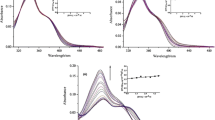Abstract
Mode of interaction of a new tetrahydrocarbazole derivative with ct-DNA has been investigated systematically using fluorescence spectroscopy, UV-Vis spectroscopy and circular dichroism spectroscopy. It is concluded that TAH could intercalate into the base pairs of ct-DNA, and the fluorescence quenching by ct-DNA was static quenching type. Beside the multispectroscopic results, computational studies were done. Molecular docking results revealed that the TAH-DNAs complexes might be classified as druggable molecule in drug design. Additionally, DNA binding studies exhibited that TAH complexes have different interaction and orientation abilities to each DNA isomer. Combination of experimental and computational data showed that reported TAH is promising structure and deserves further applications.











Similar content being viewed by others
References
Ramana MMV, Betkar R, Nimkar A, Ranade P, Mundhe B, Pardeshi S (2016) Synthesis of a novel 4H-pyran analog as minor groove binder to DNA using ethidium bromide as fluorescence probe. Spectrochim Acta Part A 152:165–171
Singh MP, Joseph T, Kumar S, Bathini Y, Lown JW (1992) Synthesis and sequence-specific DNA binding of a topoisomerase inhibitory analog of Hoechst 33258 designed for altered base and sequence recognition. Chem Res Toxicol 5:597–607
Sparks J, Scholz C (2009) Evaluation of a cationic Poly(β-hydroxyalkanoate) as a plasmid DNA delivery system. Biomacromolecules 10:1715–1719
Lown JW (1998) Anticancer Drug Des 3:25–40
Gurova K (2009) New hopes from old drugs: revisiting DNA-binding small molecules as anticancer agents. Future Oncol 5:1685–1704
Boer DR, Canals A, Coll M (2009) Dalton Trans 3:399–414
Pindur U, Jansen M, Lemster T (2005) Advances in DNA-ligands with groove binding, intercalating and/or alkylating activity: chemistry, DNA-binding and biology. Curr Med Chem 12:2805–2847
Strekowski L, Wilson B (2007) 623: 3–13
Li J, Li B, Wua Y, Shuang S, Dong C, Choi MMF (2012) Luminescence and binding properties of two isoquinoline alkaloids chelerythrine and sanguinarine with ctDNA. Spectrochim Acta Part A 95:80–85
Temerk Y, Ibrahim M, Ibrahim H, Kotb M (2015) Interactions of an anticancer drug Formestane with single and double stranded DNA at physiological conditions. J Photochem Photobiol B 149:27–36
Knolker HJ, Reddy KR (2002) Isolation and synthesis of biologically active carbazole alkaloids. Chem Rev 102:4303–4427
Sultan A, Sulthana SS, Kamil SRM, Shafi SS (2009) Indian J Heterocycl Chem 18:385–388
Gudmundsson KS, Sebahar PR, Richardson LD, Catalano JG, Boggs SD, Spaltenstein A, Sethna PB, Brown KW, Harvey R, Romines KR (2009) Substituted tetrahydrocarbazoles with potent activity against human papillomaviruses. Bioorg Med Chem Lett 19:3489–3492
Chen J, Lou J, Liu T, Wu R, Dong X, He Q, Yang B, Hu Y (2009) Synthesis and in-vitroantitumor activities of some mannich bases of 9-Alkyl-1,2,3,4-tetrahydrocarbazole-1-ones. Arch Pharm Chem Life Sci 342:165–172
Vicini P, Zani F, Cozzini P, Doytchinova I (2002) Hydrazones of 1,2-benzisothiazole hydrazides: synthesis, antimicrobial activity and QSAR investigations. Eur J Med Chem 37:553–564
Popp FD (1989) Potential anticonvulsant. XII. Anticonvulsant activity of some aldehyde derivatives. Eur J Med Chem 24:313–315
Todeschini AR, de Miranda ALP, da Silva KCM, Parrini SC, Barreiro EJ (1998) Synthesis and evaluation of analgesic, antiinflammatory and antiplatelet properties of new 2-pyridylarylhydrazone derivatives. Eur J Med Chem 33:189–199
Melnyk P, Leroux V, Sergheraert C, Grellier P (2006) Design, synthesis and in vitro antimalarial activity of an acylhydrazone library. Bioorg Med Chem Lett 16:31–35
Kocyigit KB, Rollas S (2002) Synthesis, characterization and evaluation of antituberculosis activity of some hydrazones. Farmaco 57:595–599
Morris GM, Huey R, Lindstrom W, Sanner MF, Belew RK, Goodsell DS, Olson AJ (2009) Autodock4 and AutoDockTools4: automated docking with selective receptor flexiblity. J Comput Chem 16:2785–2791
Mandal PK, Venkadesh S, Gautham N (2012) Structure of the tetradecanucleotide d (CCCCGGTACCGGGG)2 as an A-DNA duplex. Acta Crystallogr Sect F: Struct Biol Cryst Commun 68:393–399
Drew HR, Wing RM, Takano T, Broka C, Tanaka S, Itakura K, Dikerson RE (1981) Structure of a B-DNA dodecamer: conformation and dynamics. Proc Natl Acad Sci U S A 78:2179–2183
Gaussian09, RevisionE.01, Frisch MJ, Trucks GW, Schlegel HB, Scuseria GE, Robb MA, Cheeseman JR, Scalmani G, Barone V, Mennucci B, Petersson GA, et al. (2009). Gaussian, Inc., Wallingford, CT
Chattaraj PK, Giri S, Duley S (2011) Chem Rev 111:43–75
Dassault Systemes Biovia (2016) Discovery studio modeling environment release 2017. Dassault Systemes, San Diego
Lakowicz JR (2006) 3rd edn. Springer, New York
Sun Y, Bi S, Song D, Qiao C, Mu D, Zhang H (2008) Study on the interaction mechanism between DNA and the main active components in Scutellaria baicalensis Georgi. Sensors Actuators B Chem 129:799–810
Qui B, Guo L, Wang W, Chen G (2007) Biosens Bioelectron 22:2629–2635
Kumar CV, Turner RS, Asuncion EH, Photochem J (1993) Groove binding of a styrylcyanine dye to the DNA double helix: the salt effect. Photobiol A Chem 74:231–238
Wu M, Wu W, Lian X, Lin X, Xie Z (2008) Synthesis of a novel fluorescent probe and investigation on its interaction with nucleic acid and analytical application. Spectrochim Acta Part A 71:1333–1340
Ross PD, Subramanian S (1981) Thermodynamics of protein association reactions: forces contributing to stability. Biochemistry 20:3096–3102
Bi S, Yan L, Sun Y, Zhang H (2011) Investigation of ketoprofen binding to human serum albumin by spectral methods. Spectrochim Acta Part A 78:410–414
Maheswari PU, Palaniandavar M (2004) DNA binding and cleavage properties of certain tetrammine ruthenium(II) complexes of modified 1,10-phenanthrolines – effect of hydrogen-bonding on DNA-binding affinity. J Inorg Biochem 98:219–230
Garbett NC, Ragazzon PA, Charires JB (2007) Nat Protoc 12:3166–3172
Acknowledgements
This work was supported by the Scientific and Technical Research Council of Turkey (TUBITAK) - Grant No 114Z391.
Author information
Authors and Affiliations
Corresponding author
Electronic supplementary material
ESM 1
(DOC 76 kb)
Rights and permissions
About this article
Cite this article
Ozkan, S., Taskin-Tok, T., Uzgoren-Baran, A. et al. Multispectroscopic and Computational Investigation of ct-DNA Binding Properties with Hydroxybenzylidene Containing Tetrahydrocarbazole Derivative. J Fluoresc 29, 101–110 (2019). https://doi.org/10.1007/s10895-018-2314-4
Received:
Accepted:
Published:
Issue Date:
DOI: https://doi.org/10.1007/s10895-018-2314-4




